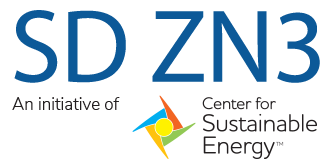Frequently Asked Questions
CSE is aligning its ZNE goals for the SD ZN3 Project with the Energy Commission's zero net energy code building definition as stated in 2013 California Energy Commission Integrated Energy Policy Report.
"A Zero-Net-Energy Code Building is one where the net amount of energy produced by on-site renewable energy resources is equal to the value of the energy consumed annually by the building, at the level of a single ‘project’ seeking development entitlements and building code permits, measured using the Energy Commission's Time Dependent Valuation metric. . . . A zero-net-energy code building meets an energy use intensity value designated in the Building Energy Efficiency Standards by building type and climate zone that reflect best practices for highly efficient buildings."
ZNE buildings are high performing buildings that produce an equivalent amount of renewable energy as the amount of energy they consume, reducing overall greenhouse gas emissions. Additionally, ZNE projects help property owners cut utility costs and promote economic development, which strengthen local economies.
Twelve consecutive months of data need to be collected to verify that a building has achieved the CA ZNE status. Metered data will allow building owners to verify that the energy consumed by the building is offset by an equivalent (or greater) amount of renewable energy.
The process to convert a portfolio of buildings to ZNE includes the following actions:
- Enact ZNE policies or update existing green policies to support ZNE buildings.
- Conduct benchmarking to generate and compare energy scores among buildings.
- Conduct audits on high priority buildings to plan retrofit measures.
- Explore energy savings performance contracts (ESPCs), power purchase agreements (PPAs) and other financing mechanisms for energy projects that will mitigate your capital expenditures.
- Continue benchmarking post retrofit to assess results and consider disclosing energy benchmarking results as part of a larger energy disclosure/energy efficiency awareness program.
Energy efficiency measures refer to technologies or processes that are put in place to improve a building’s energy efficiency. They include upgrades in building operations and maintenance, lighting, office equipment and heating and cooling.
Demand response (DR) is a process in which energy consumers are able to play a role in the operation of the electric grid by reducing or shifting electricity demand during peak periods. Most utilities provide opportunities for consumers to participate in such programs. Consumers who do so are usually compensated for the curtailed energy. Find out more about SDG&E’s DR programs.
The ability to shift or curtail demand during peak periods will reduce congestion on the grid and offset the use of expensive gas-fired peaker plants. Participation in demand response programs not only increases grid reliability, but also provides additional revenue streams for participating customers.
Integrated demand-side management (IDSM) is a process that includes energy efficiency, energy conservation, demand response, advanced metering and distributed energy resources as elements of an integrated system that provides benefits to consumers, the electric grid and the environment.
CSE provides a diverse range of services that promote energy efficiency and clean building performance through program design and implementation, workforce development, technical consulting and policy innovation. See our list of CAPABILITIES to see how we can help you!
ZNE Webinars
Learn from experts about going ZNE by exploring past webinars.
